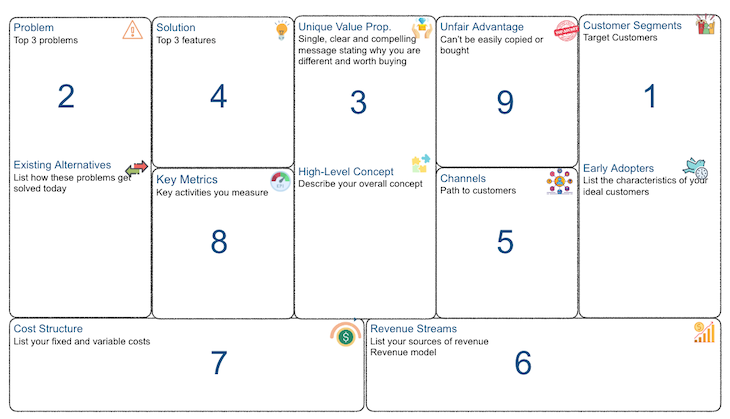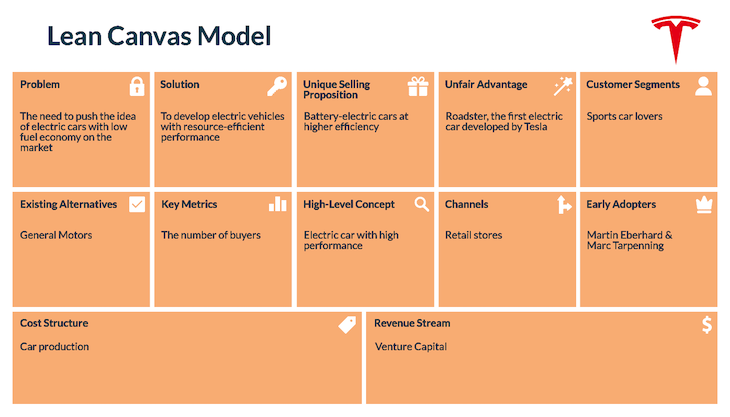When I worked as a business analyst, crafting and adhering to a business plan used to drive me nuts. I’d spend hours thinking over every aspect of our product, only to feel overwhelmed by the volume of information I collected.

A business plan aims to foster a shared understanding of your product so that your team knows how to prioritize their time. However, I found this extremely difficult when working out of a 30 page document littered with advanced spreadsheets. Often, it was so complicated that it created more waste than value.
Thankfully, Ash Maurya, founder of LEANSTACK, came up with the Lean Canvas, a product management template that enables you to develop a new business and understand its essential aspects.
In this article, you will learn what a Lean Canvas is, how to use it, and how it differs from traditional business model canvases.
A Lean Canvas is a single, visual document that outlines all the critical aspects you need to consider when moving from a potential idea to a mature business.
Constructing a Lean Canvas is more than just a simple brainstorm. During the process, you make decisions on business fundamentals by iterating, learning, and adapting.
You can easily create a Lean Canvas, as long as you think strategically about your prospective product. Gathering all the blocks together can be time consuming, but a well crafted Lean Canvas will accelerate your decision-making and allow you to focus on what matters most.
When crafting a Lean Canvas, you need to follow a specific order that lets you develop a clear story for your product. A Lean Canvas looks like:

You can download a copy of this template for yourself here.
Within the template, there are nine distinct boxes to fill:
First comes your customers. Without them, you have nothing.
Define the target audience you aim to serve as precisely as possible. You can have different levels. Make them clear and start by focusing on the earliest adopters.
For example, Tesla initially targeted sports car lovers because it wanted to create a fancy electric car. As early adopters, they got Martin Eberhard, an American inventor, and Marc Tarpenning, an American engineer. Although they co-founded Tesla, they started using cars so others could become interested in them.
Name the problems your target audience faces. Make the problems brief and easy to understand. Mention the available alternatives to the identified problems.
Going back to our example, Tesla visualized the problem of high fuel consumption and wanted to foster an alternative to it. The current options were other car brands, such as General Motors.
Define why customers would come to you. In other words, make it clear how you create value by addressing the problems of your customer segments.
Tesla revolutionized the electric vehicle movement by introducing high efficiency batteries that stood up against their gas counterparts. Because Tesla produced a product that no one else had, it was able to carve out a unique market niche and present consumers with value.
Reflect on how you solved the problem by describing your solution in a high-level way. It might help if you focus on the top three features that you want your product to deliver. Products succeed when they target a problem and then introduce a novel solution to the market.
For instance, Tesla aimed to develop electric cars with high performance. That decision pushed Tesla towards a particular type of consumer aimed at true car enthusiasts.
When designing any product, it’s important that you anticipate how and where your customers will interact with your solution. This is where channels come into play. You might want to sell directly to customers in retail stores, distribute online, or work through wholesale agreements.
Tesla opened direct-to-consumer retail stores to build a closer relationship with its customers. You can do the same, or explore different options like affiliates, sales force, etc.
Think about where your income will come from. Most successful products find more than one revenue stream. These might be from subscriptions, premium subscribers, ads, commission, etc.
Tesla initially didn’t have a revenue stream, but it had venture capital funds. As the company matured, it found additional ways to generate consistent revenue and moved away from its reliance on outside funding.
Now comes the critical aspect. You have to understand how to organize your cost structure so that you can deliver on your promises.
What do you need to keep delivering your solutions? Some examples are development, marketing, and payroll costs.
Tesla’s top priorities were car production costs, research and development, and technology.
New ideas are fragile and you will run into some obstacles. Because of this, it’s important to know how you measure success.
Set three to five key metrics to ensure your business is booming.
Tesla’s initial goal was to have people buy its cars. It strived to prove a market fit.
Protect your unfair advantage at all costs. For example, Google has the most advanced web search and has protected it for so long that the company’s name became a verb.
The unfair advantage reflects what you have that others cannot easily copy. The more complicated it is to copy, the stronger your unfair advantage is.
Tesla had the unfair advantage of pioneering electric sports cars, putting it ahead of their competitors.
The following image represents Tesla’s Lean Canvas:

You probably won’t get a Lean Canvas right from the beginning. On the way, you’ll learn and need to adapt.
I recommend going block-by-block and asking what your assumptions are. Let’s continue using Tesla as an example:
These represent some of the assumptions of the business model. The key is to test the most critical ones. Categorize assumptions based on evidence and how critical they are. Then focus on testing the most critical ones where you lack supporting evidence:

You can download this template here.
It’s normal to pivot solutions, audiences, and problems. Continuously iterate until you have solid evidence supporting your business model. Remember that Netflix started by renting DVDs per post, then moved to streaming, and now it has advertisements.
Successful business models adapt to present realities.
You may stumble upon the business model canvas and find yourself confused whether to use it or move onto a Lean Canvas. These aren’t mutually exclusive, but they have a few core differences.
The business model canvas focuses on the business aspects. It shows you the fundamental parts of keeping your business running. For example, it addresses the key activities, partners, and resources. Such elements relate to running a business and not bringing an idea to life.
A Lean Canvas focuses on an idea and its characteristics. It helps you understand the vital aspects behind the idea — the problem it solves, how you differentiate, how to measure success, and your unfair advantage.
Combining the business model canvas and a Lean Canvas can be powerful, but first you should decide on what you’re trying to achieve, then pick the most appropriate option or join both.
Here’s an example of what a business model canvas would look like for Tesla:

The Lean Canvas isn’t a template to fill and forget about. Instead, it’s a tool to foster collaboration and clarify the essential aspects of your idea. Your first model probably won’t be right; keep iterating until you identify a direction worth pursuing.
These are the key takeaways:

LogRocket identifies friction points in the user experience so you can make informed decisions about product and design changes that must happen to hit your goals.
With LogRocket, you can understand the scope of the issues affecting your product and prioritize the changes that need to be made. LogRocket simplifies workflows by allowing Engineering, Product, UX, and Design teams to work from the same data as you, eliminating any confusion about what needs to be done.
Get your teams on the same page — try LogRocket today.

Promotions depend on proof. This guide shows PMs how to capture wins, feedback, and impact before review season.

Most teams fail at autonomy. Learn how clear rules help product teams move faster without micromanagement.

A practical framework for PMs to use AI in ideation without sacrificing judgment, strategy, or decision quality.

A practical five minute revenue estimation method to help product managers compare ideas, drop low impact features, and prioritize smarter.